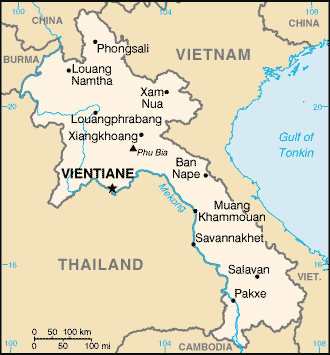
Laos' population is increasing at an average of 2.5 percent each year, with the 2000 population estimates at over 5.2 million, with women outnumbering men. It is estimated that if Laos continues to grow at it's current rate, the it's population will almost double in the next 25 years.
As life expectancy at birth is 55 years, only a small fraction of the population is over 60 years old and almost half of the remaining population (approximately 45 percent) under the age of 15.
The population density of Laos is the lowest in Asia, with about 21 people per square kilometer with the overwhelming majority of the population residing in rural areas.
There are about 49 ethnic groups in Laos with 4 main linguistic families that are found all across Lao with each comprising their own culture and traditions. These groups can be classified into three separate groups: approximately 56% in Lao Lum (Lowlanders), 34% in Lao Theung (uplanders), and 9% Lao Soung (hill tribes). (1993 estimate)
The linguistic families are Lao-Tai; Mone-Khmer; Tibeto-Burmese; and the Hmong-Ioumein. The eight groups within the Lao-Tai family are - Gnaheune, Gnouane, Lao, Lue, Phouthai, Saek, Tai, Thai Neua, and Young.
Mone-Khmer consists of 32 groups, among them are the Bid, Brao, Harak, Idou, Kabkae, Katang, Katou, Khmer, Khmu, Khom, Kri, Krieng, Lavy, Lamed, Makong, Meuang, Ngouane, Oi, Pray, Samtao, Singmou, Souai, Ta-oi, Thene, Toum, Trieng, Try, Yeh and Yrou.
Seven groups are within the Tibeto-Burmese family - Ahka, Hayi, Hor, Lahou, Lolo, Sila, and Singsali. The Hmong-Ioumen family has two main ethnic groups comprising it - the Hmong and the Ioumein (Yao).
There have been many attempts at establishing a formal school system, whether for the elite only or for the general population, but they have for the most part not been successful.
Laos' economy depends on several things for it's survival - agriculture, handicrafts, fishing and on a small scale manufactured clothing. It is a poor country that depends on outside sources such as Japan, France, Sweden and Australia to make come to it's aid. The overwhelming majority of laborers are in the agricultural field, while laborers in the service industry come in at a distant second.
One of Laos' major exports is that of timber, with most of them exported as logs and not processed. The only crop that can be considered a substantial export is coffee. Since the late 1980's tourism has been encouraged, although there isn't a boom of tourism, the numbers were rapidly increasing up through the late 1990's.
Lao is the official language of Laos and uses a derivative of a Southern Indian script for it's alphabet. There are four main indigenous language groups in Laos: Daie (Tai-Kadai), Hmong-Mien, Mon-Khmer and Tibeto-Burman. In addition, there are many subgroups of these languages, some of which are only used by a very small minority.
Foreign languages used in Laos are English and French, which are primarily used in business transactions.
 A
A
Laos' landscape is characterized by precipitous mountains; long, fertile floodplains, and lastly, high plateaus. The mountains are found all throughout Laos but are mainly in the northern part of the country as are three main plateaus which are found in the north, central and southern sections of the country. The floodplains span from the north, where they are narrow, to the south where they are much wider.
The tropical monsoon climate of Laos has average temperatures ranging from 28 degrees C to 38 degrees C. The mountainous areas generally stay much cooler with average temperatures of 15 degrees C during winter. Laos' rainy season is from May to September, while the dry season is from October to April.
The most important river in Laos is the Mekong River with it being navigable through most of Laos.
There is no official religion in Laos, although the largest religion, Buddhism, has a large impact on the country's culture. Another religion, animism, is not as popular as Buddhism, but has carried over some of it's traditions into modern-day Laos. Brahmanism is another religion that was worshipped (which came from India). Other religions, such as Christianity (Catholic and Protestant) and Islam are also found in small numbers.
Tidak ada komentar:
Posting Komentar